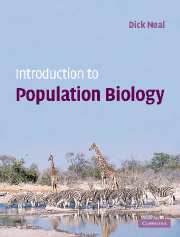Book contents
- Frontmatter
- Contents
- Preface
- Acknowledgements
- PART I Evolution by natural selection
- PART II Simple population growth models and their simulation
- Chapter 4 Density-independent growth and overproduction
- Chapter 5 Density-dependent growth, and the logistic growth model
- PART III Population genetics and evolution
- PART IV Demography
- PART V Interactions between species, and the behaviour of individuals
- Glossary
- Solutions to problems
- References
- Index
Chapter 4 - Density-independent growth and overproduction
- Frontmatter
- Contents
- Preface
- Acknowledgements
- PART I Evolution by natural selection
- PART II Simple population growth models and their simulation
- Chapter 4 Density-independent growth and overproduction
- Chapter 5 Density-dependent growth, and the logistic growth model
- PART III Population genetics and evolution
- PART IV Demography
- PART V Interactions between species, and the behaviour of individuals
- Glossary
- Solutions to problems
- References
- Index
Summary
Darwin noted that on average parents produce more offspring during their lifetime than are needed to replace themselves, and so populations have the potential to increase in number. This fact is one of the cornerstones of his theory of natural selection and we can ask why organisms should have this characteristic? Why should there be an overproduction of offspring? Perhaps the easiest way to answer this question is to consider the fate of populations which do not have this characteristic. Obviously, if individuals cannot fully replace themselves, the population will decline to zero and be eliminated. Populations adopting an exact replacement strategy suffer the same fate, because there is always a chance that some individuals will die before they reproduce and so these populations will decline to extinction as their reproductive base shrinks. Thus, although natural selection can select for any reproductive rate, providing that rate leaves the most descendants, only those populations where there is an overproduction of offspring survive over the long term, the others are eliminated.
We can conclude that overproduction is one of the necessary conditions for the long-term survival of populations, allowing them to compensate for pre-reproductive losses and to recover from reductions in population size. We can make similar arguments for the long-term survival of variation in the population. There must be overproduction of copies of specific variants if they are to survive and not be eliminated from the population, and we should bear these facts in mind when we consider the production of new variation by mutation in Chapter 7 and the selection of different variants in Chapters 10 to 12.
- Type
- Chapter
- Information
- Introduction to Population Biology , pp. 53 - 67Publisher: Cambridge University PressPrint publication year: 2003



